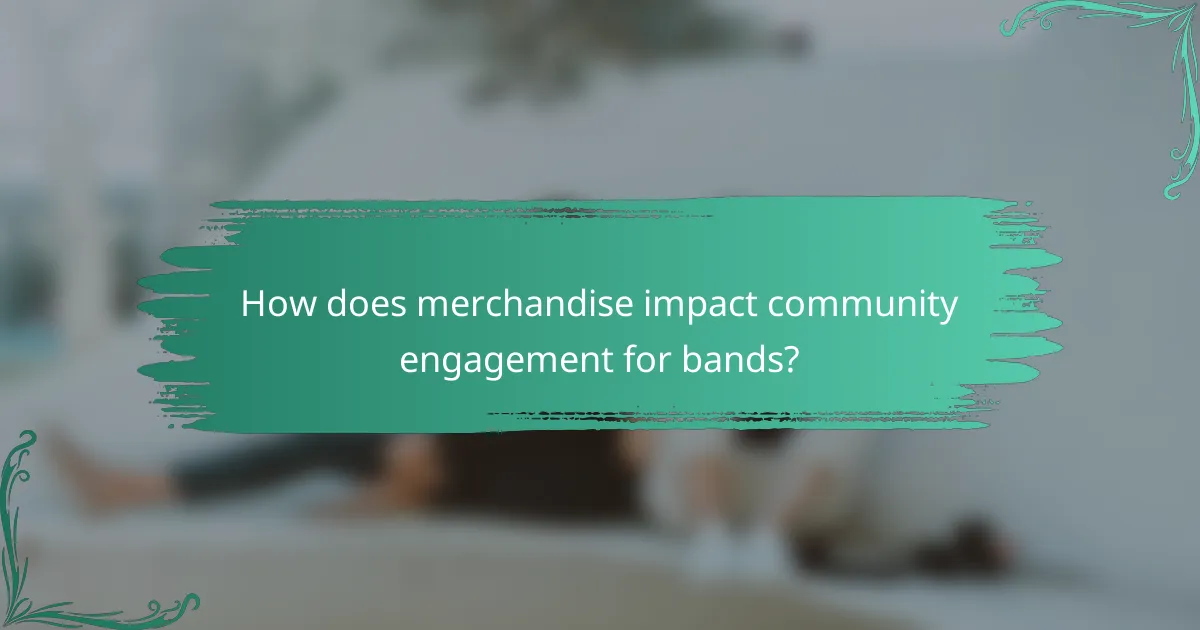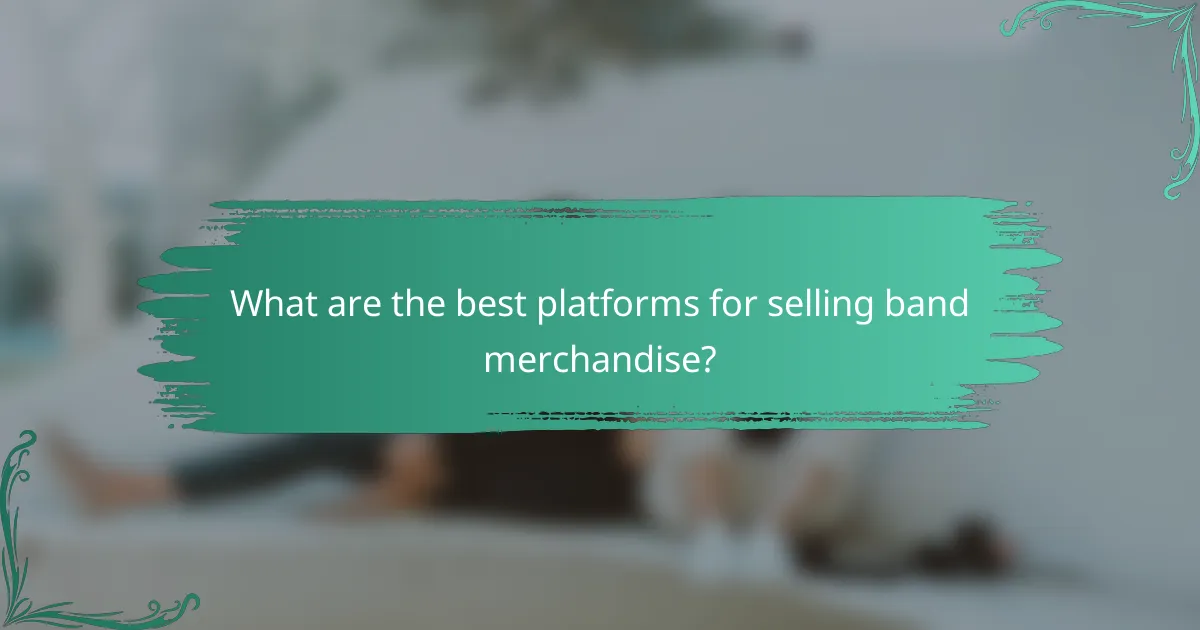Merchandise plays a crucial role in enhancing community engagement for bands, creating a tangible link between artists and their fans. By offering items like apparel and collectibles, bands not only generate revenue but also foster loyalty and a sense of belonging within their fanbase.

How does merchandise impact community engagement for bands?
Merchandise significantly enhances community engagement for bands by fostering a deeper connection between artists and their fans. It serves as a tangible representation of support, allowing fans to express their loyalty while also promoting the band’s brand within their social circles.
Increased fan loyalty
Offering merchandise can strengthen fan loyalty by creating a sense of belonging among supporters. When fans wear or use band-branded items, they feel more connected to the music and the community surrounding it. This emotional investment often translates into increased attendance at concerts and higher engagement on social media platforms.
To cultivate loyalty, bands should consider exclusive merchandise options, such as limited-edition items or fan club-only products. This exclusivity can encourage fans to invest more in the band, both financially and emotionally.
Enhanced brand visibility
Merchandise acts as a powerful marketing tool, increasing brand visibility as fans showcase their support in public spaces. Each item worn or displayed serves as a conversation starter, potentially attracting new listeners and expanding the band’s audience.
To maximize visibility, bands should focus on creating visually appealing designs that resonate with their target audience. Collaborating with local artists for unique merchandise can also enhance the brand’s image and appeal.
Revenue generation
Merchandise sales can provide a significant revenue stream for bands, especially in an industry where traditional income sources like album sales are declining. By offering a range of products, from apparel to accessories, bands can cater to different fan preferences and budgets.
To optimize revenue, bands should analyze their sales data to identify popular items and trends. Setting competitive prices while ensuring quality can help maintain customer satisfaction and encourage repeat purchases. Additionally, utilizing online platforms for sales can broaden reach beyond local markets, tapping into international fan bases.

What types of merchandise are most effective for bands?
Effective merchandise for bands typically includes apparel, music formats, and collectibles that resonate with fans. These items not only generate revenue but also enhance community engagement and brand loyalty.
Apparel and clothing
Apparel is one of the most popular merchandise categories for bands, as it allows fans to showcase their support. T-shirts, hoodies, and hats featuring band logos or artwork can be effective in creating a sense of belonging among fans.
When designing apparel, consider using high-quality materials and unique designs to stand out. Limited edition items can create urgency and encourage fans to purchase quickly, while offering a variety of sizes ensures inclusivity.
Music and vinyl records
Music merchandise, particularly vinyl records and CDs, remains a vital aspect of a band’s offerings. Many fans appreciate physical formats that provide a tangible connection to the music, often seeking special editions or autographed copies.
To maximize sales, consider bundling music with other merchandise, such as apparel or accessories. Offering digital downloads alongside physical products can also cater to fans who prefer streaming but still want a collectible item.
Accessories and collectibles
Accessories and collectibles, such as posters, pins, and keychains, serve as affordable options for fans to engage with the band. These items can be particularly appealing at live shows or events, where fans are looking for mementos.
Creating limited edition collectibles can drive excitement and encourage fans to make impulse purchases. Additionally, consider collaborating with local artists for unique designs that reflect the band’s identity and resonate with the community.

How can bands leverage merchandise for community building?
Bands can effectively leverage merchandise to foster community building by creating a sense of belonging and connection among fans. By offering unique products that resonate with their audience, bands can strengthen their brand loyalty and encourage fan engagement.
Hosting pop-up shops
Hosting pop-up shops allows bands to engage directly with their community while selling exclusive merchandise. These temporary retail spaces can be set up in local venues, festivals, or even popular community spots, providing fans with a unique shopping experience.
Consider scheduling pop-up events around album releases or special occasions to maximize attendance. Promote these events through social media and local advertising to attract a larger crowd and create buzz.
Collaborating with local artists
Collaborating with local artists can enhance merchandise appeal and strengthen community ties. By featuring local designs or artwork on band merchandise, bands can create unique items that reflect the local culture and resonate with fans.
This approach not only supports local talent but also encourages fans to feel a deeper connection to both the band and their community. Consider hosting joint events or exhibitions to showcase the collaboration, further engaging your audience.
Creating exclusive merchandise for events
Creating exclusive merchandise for specific events can drive excitement and increase sales. Items like limited-edition t-shirts, posters, or vinyl records can become coveted collectibles for fans attending concerts or festivals.
Ensure that these exclusive items are promoted ahead of time to generate interest. Consider offering pre-orders or bundles that include event tickets, which can enhance the overall experience for fans and boost merchandise sales.

What are the best platforms for selling band merchandise?
The best platforms for selling band merchandise include Bandcamp, Etsy, and Shopify, each catering to different needs and types of products. Choosing the right platform depends on the type of merchandise you offer, your target audience, and your sales strategy.
Bandcamp for music sales
Bandcamp is ideal for musicians looking to sell their music directly to fans. It allows artists to set their own prices and offer digital downloads, physical copies, and merchandise bundles.
One key advantage of Bandcamp is its built-in community features, which help artists engage with their audience through comments and messaging. Additionally, Bandcamp takes a small percentage of sales, making it a cost-effective option for independent artists.
Etsy for handmade items
Etsy is a popular platform for selling handmade and unique items, making it a great choice for bands that create custom merchandise like apparel, art, or accessories. The platform allows sellers to reach a large audience interested in artisanal products.
When using Etsy, ensure your listings are well-optimized with high-quality images and detailed descriptions. Keep in mind that Etsy charges listing fees and takes a percentage of each sale, so factor these costs into your pricing strategy.
Shopify for e-commerce
Shopify is a robust e-commerce platform that enables bands to create their own online store. This option is particularly beneficial for those looking to build a brand and sell a wide range of merchandise, from clothing to music.
With Shopify, you have full control over your store’s design and functionality, allowing for a tailored shopping experience. However, it comes with monthly fees and transaction costs, so be prepared to invest in your online presence to maximize sales potential.

How can social media enhance merchandise sales?
Social media can significantly boost merchandise sales by creating direct connections between bands and their fans. By leveraging platforms like Instagram, Facebook, and TikTok, bands can promote their products, engage their audience, and drive traffic to their online stores.
Engaging with followers
Engaging with followers is crucial for enhancing merchandise sales. Bands should respond to comments, share fan-generated content, and create polls or questions to foster interaction. This builds a community around the band, making fans feel valued and more likely to purchase merchandise.
Consider hosting Q&A sessions or behind-the-scenes content to deepen the connection. Regular engagement can lead to increased loyalty and repeat purchases, as fans feel more invested in the band’s journey.
Running targeted ad campaigns
Targeted ad campaigns on social media platforms can effectively reach potential customers. By using demographic data and interests, bands can tailor ads to specific audiences, increasing the likelihood of sales. Setting a budget that allows for testing different ad formats can help identify what resonates best with fans.
Utilize tools like Facebook Ads Manager to track performance and adjust campaigns accordingly. A/B testing different visuals or messages can lead to improved conversion rates, ensuring that the investment in advertising yields a positive return.
Showcasing merchandise in live streams
Live streaming offers a dynamic way to showcase merchandise directly to fans. Bands can host live events where they display new products, offer exclusive discounts, and interact with viewers in real-time. This creates a sense of urgency and excitement around merchandise sales.
Incorporating limited-time offers during live streams can encourage immediate purchases. Promote these events in advance to maximize attendance, and consider using platforms like Instagram Live or YouTube Live for broader reach.

What are the key metrics for measuring merchandise success?
Key metrics for measuring merchandise success include sales volume, profit margins, and customer engagement levels. These metrics help bands understand their merchandise performance and make informed decisions about future offerings.
Sales volume analysis
Sales volume analysis focuses on the total number of merchandise items sold over a specific period. This metric is crucial for assessing the popularity of different products and identifying trends in consumer preferences.
To conduct a sales volume analysis, track the number of units sold for each item, categorize them by type (e.g., apparel, accessories), and compare these figures across different events or time frames. For example, a band might notice that T-shirts sell significantly better at live shows than online.
When analyzing sales volume, consider seasonality and promotional efforts. Offering discounts during peak times, such as holidays or tour dates, can boost sales. Avoid overstocking items that consistently underperform to minimize losses.
